

ESE205 - Lab 8 : Capacitors (part 2) UNIVERSITY of PENNSYLVANIA DEPARTMENT of ELECTRICAL ENGINEERING ESE Undergraduate Laboratory ESE205: Electrical Circuits and Systems I Laboratory Capacitors (Part 2) - Pulse Counter and Self Timer Goals To build two complex circuits that use capacitors and op-amps to perform various functions.

Familiarize yourself with the exponential waveform learn about parallel and series combinations of capacitors observe the filtering action of an RC circuit Background In the previous lab you learned that capacitors can store charges and act as short-term memory elements (that is the basis for the operation of DRAMs in your PC). I = C × dV/dt Indeed, one can solve the above equation for V to get, Thus, the voltage increases linearly with time. Figure 1: (a) Capacitor charged by a constant current I and the hydraulic equivalent; (b) the voltage over the capacitor as a function of time. In the beginning when no charge is stored on the capacitor, the voltage V over the capacitor is zero. 1. 2. 3. 4.
Find: b. Charging capacitor bank with current limiting circuit. Ultracapacitor & Supercapacitor Frequently Asked Questions - Tecate Group. Electric double-layer capacitors, also known as supercapacitors, electrochemical double layer capacitors (EDLCs) or ultracapacitors are electrochemical capacitors that have an unusually high energy density when compared to common capacitors, typically several orders of magnitude greater than a high-capacity electrolytic capacitor.
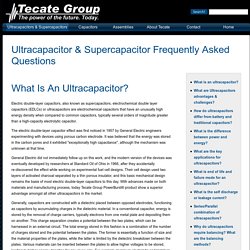
The electric double-layer capacitor effect was first noticed in 1957 by General Electric engineers experimenting with devices using porous carbon electrode. It was believed that the energy was stored in the carbon pores and it exhibited "exceptionally high capacitance", although the mechanism was unknown at that time. General Electric did not immediately follow up on this work, and the modern version of the devices was eventually developed by researchers at Standard Oil of Ohio in 1966, after they accidentally re-discovered the effect while working on experimental fuel cell designs.
Lessons In Electric Circuits. Electrical transients This chapter explores the response of capacitors and inductors to sudden changes in DC voltage (called a transient voltage), when wired in series with a resistor.

Unlike resistors, which respond instantaneously to applied voltage, capacitors and inductors react over time as they absorb and release energy. Capacitor transient response Because capacitors store energy in the form of an electric field, they tend to act like small secondary-cell batteries, being able to store and release electrical energy. A fully discharged capacitor maintains zero volts across its terminals, and a charged capacitor maintains a steady quantity of voltage across its terminals, just like a battery. When the switch is first closed, the voltage across the capacitor (which we were told was fully discharged) is zero volts; thus, it first behaves as though it were a short-circuit. Capacitor charging v1 1 0 dc 15 r1 1 2 10k c1 2 0 100u ic=0 .tran .5 10 uic .plot tran v(2,0) v(1,2) .end. Capacitance, Charging and Discharging of a Capacitor.
Capacitance Capacitance of a capacitor is defined as the ability of a capacitor to store the maximum electrical charge (Q) in its body.
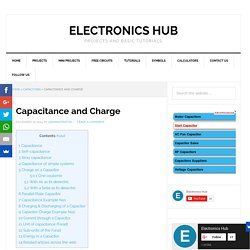
Here the charge is stored in the form of electrostatic energy. The capacitance is measured in the basicSI units i.e. Farads. Testing Electrochemical Capacitors: Cyclic Charge-Discharge-Stacks. Introduction This application note is Part of 2 describing electrochemical techniques for energy-storage devices.
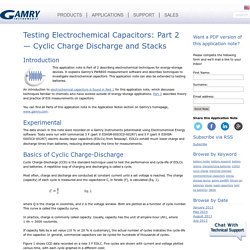
It explains Gamry’s PWR800 measurement software and describes techniques to investigate electrochemical capacitors. This application note can also be extended to testing batteries. An introduction to electrochemical capacitors is found in Part 1 for this application note, which discusses techniques familiar to chemists who have worked outside of energy-storage applications.
Part 3 describes theory and practice of EIS measurements on capacitors. You can find all Parts of this application note in the Application Notes section on Gamry’s homepage, www.gamry.com. Experimental The data shown in this note were recorded on a Gamry Instruments potentiostat using Electrochemical Energy software. Capacitors and batteries. Capacitors: devices for storing charge A capacitor is a device for storing charge.
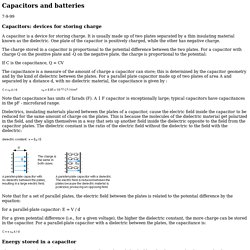
It is usually made up of two plates separated by a thin insulating material known as the dielectric. One plate of the capacitor is positively charged, while the other has negative charge. The charge stored in a capacitor is proportional to the potential difference between the two plates. For a capacitor with charge Q on the positive plate and -Q on the negative plate, the charge is proportional to the potential: If C is the capacitance, Q = CV. An Introduction To Capacitors. Capacitors.

Electrolytic capacitor. Most common styles of aluminum and tantalum electrolytic capacitors.
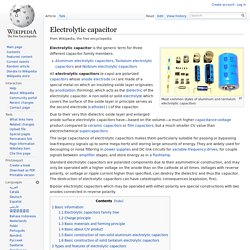
Des condensateurs chimiques. Tout d'abord quelques autres résultats.
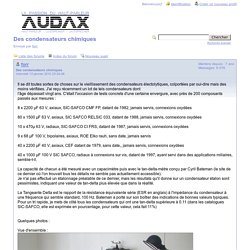
Chimiques basse tension (< 100 V) 2 x 6800 µF, 50 V, radiaux, diamètre 2.7 cm x hauteur 5 cm x ELNA-JVC, sans date mais assez récents, provenant d'un amplificateur JVC (pseudo-) classe A. 6500 et 6600 µF, tan-delta < 0.1 2 x 8000 µF, 45 V, radiaux, diamètre 3 cm x hauteur 5.2 cm, logo MITSUBISHI (?) , sans date, provenant d'un ampli. Ceramic capacitor. Fixed leaded disc and multilayer ceramic capacitors (MLCC) A ceramic capacitor is a fixed value capacitor in which ceramic material acts as the dielectric.

It is constructed of two or more alternating layers of ceramic and a metal layer acting as the electrodes. The composition of the ceramic material defines the electrical behavior and therefore applications. Aluminum electrolytic capacitor. Aluminum electrolytic capacitors with non-solid electrolyte have a wide range of styles, sizes and series An aluminum electrolytic capacitor, usually simply called an electrolytic capacitor (e-cap), is a capacitor whose anode (+) consists of pure aluminum foil with an etched surface, covered with a uniformly very thin barrier layer of insulating aluminum oxide which operates as a dielectric.
The electrolyte, which covers the rough surface of the oxide layer, operates as the second electrode, the cathode (-). Electrolytic, Variable & Film Capacitors. Introduction There are different types of capacitors available in the present days. They each vary in their characteristics and applications. Because each have their own advantages and disadvantages. Few types of capacitors can charge up to higher voltages such as electrolytic capacitors.Sothey can be used in high voltage power correction and smoothing circuits. Some capacitors have very low leakage rates and others have very high leakage rates. The differences between the different types of capacitors are generally made with according to the dielectric material which is used between the metal plates.
In general small capacitors are constructed with ceramic materials and these are sealed by dipping them in to an epoxy region. Passive Components content from Power Electronics. Wet tantalum capacitors now use the intrinsic capability of a proprietary cathode system to provide high capacitance/voltage characteristics, allowing them to be qualified to DSCC 93026. The Next generation of wet tantalum capacitor technology enables both higher-efficiency and higher-reliability capacitor designs, extending their application capabilities. Traditional wet tantalum capacitors use a sleeve of pressed and sintered tantalum powder for the cathode system.
Devices manufactured in this manner are qualified to the military specification 39006. The key to higher-efficiency wet tantalum capacitor technology, such as those manufactured to the military drawing 93026, is the use of a more volumetrically efficient cathode system, which in turn enables a larger internal capacitor element (referred to as “anode”) to be used.
Traditionally, for the cathode system, a metal oxide, such as ruthenium oxide, or a carbon cathode, such as a carbon palladium system, has been used. Capacitors, Part 6 "Electrolytic Capacitors [1]" ■Electrolytic capacitor types An electrolytic capacitor is a capacitor that uses an oxide film made of aluminum, tantalum or other oxidizable metal as a dielectric. Because of its potential for large capacitance, this type of capacitor is used extensively in power supply circuits and similar applications. There are two major categories, using either a water-based (wet) electrolyte or solid electrolyte. These categories can be further subdivided as shown below. Electrolytic capacitors normally have polarity, but there are also nonpolar types. High Stability & Reliability Silicon Capacitors. Advanced USB Device Charger.
Determining Dielectric Constant and Loss Tangent in FR 4. Dielectric Characteristics - Wright Capacitors, Inc. Wright Capacitors Inc. has a wide selection of dielectrics to suit your application whether it be for pulse power / detonation, high temperature, high voltage or high frequency. Basic electrical characteristics of our main dielectric types are shown below. Electrical Operating Temperature Range: Class I and II: -55° to + 125°C (higher temperature to 300°C available) Class III: Z5U + 10° to 85°C.
Temperature Characteristics: Method 302. Edn. Introduction Multilayer ceramic capacitors (MLCCs) are used extensively in modern electronics because they offer high volumetric efficiencies and low equivalent series resistances at attractive prices. These advantages make MLCCs nearly ideal for a wide range of applications, including output capacitors for power supplies and local decoupling capacitors for integrated circuits. The various types of MLCCs are delineated primarily by their temperature coefficient, which is the amount of variation in their capacitance over a specified temperature range.
Class I types, given a designation of NP0 or C0G, must vary less than +/–30 ppm over their operating temperature range, while Class II types can change anywhere from +/–15 percent (X7R) to +22 percent /–82 percent (Z5V) [1]. The temperature coefficient of an MLCC is a direct effect of the materials used in the ceramic that forms the capacitor dielectric. Active Signal Technologies Very High Temperature Ceramic Capacitors. Active Signal Technologies, in collaboration with the New York State College of Ceramics at Alfred University (NYSCC at AU) has developed a new family of ceramic dielectrics for use in next generation military avionics and other high temperature applications.i,ii Starting with the bismuth sodium titanate {(Bi0.5Na0.5)TiO3, NBT} system, traditionally considered a candidate for lead-free piezoelectric formulations, the team investigated numerous formulation and processing modifications to meet application requirements.
This included an exhaustive matrix of substituents on the A and B site of the perovskite lattice together with secondary additives, to optimize electrical performance while minimizing piezoelectric strain. Electrochemical Double Layer Capacitors (Supercapacitors) Marjan Aslani December 14, 2012 Submitted as coursework for PH240, Stanford University, Fall 2012 Electrochemical double layer capacitors, also known as supercapacitors or ultracapacitors, are energy storage elements with high energy density compared to conventional capacitors and high power density compared to batteries.
Unlike conventional capacitors, where no chemical reactions is used and small amount of energy is stored by physically storing electric charges between two conductive plates upon application of an electric field, these electrochemical storage devices cross the boundary into battery technology by using special electrodes and electrolyte, and have capacitance values as high as 3500 Farads in a single standard case size with long cycle life (>100 000 cycles). [1] Supercapacitors are the preferred choice in applications requiring a large amount of energy to be stored and delivered in bursts repeatedly.
Lithium-ion capacitor. Choosing between ceramic and tantalum capacitors - 31 October 2007 - Avnet South Africa - Dataweek. Choosing between ceramic and tantalum capacitors31 October 2007, Passive Components An important stage in the development of an electronic circuit is that of component selection. The engineer must choose the best components after defining the functional parameters and operating temperature range of the circuit. Electronic Component News.
Size, performance, reliability and cost are the common standards to judge any electronic device. As consumers, we expect smaller, cheaper and more powerful devices that are of high quality and reliability. Within any given system, we can take semiconductors' improved performance, size and cost as a certainty. However, it is the never-ending trend to develop more powerful semiconductors with lower power consumption that is pushing passive components to their limit. Supercapacitors + battery. 1280px-Energiespeicher3.svg.png (PNG Image, 1280 × 723 pixels) - Scaled (80%) Advanced Capacitors 2012. 最新キャパシタマーケット調査資料 好評発売中! Patent EP0112923A1 - Double electric layer capacitor - Google Patents. Shake, rattle and roll - tougher electrolytics master vibrations in automative applications - 9 May 2001 - Electrocomp - Dataweek. Shake, rattle and roll - tougher electrolytics master vibrations in automative applications9 May 2001, Passive Components Automotive electronics calls for rugged components of extreme reliability.
Murata Manufacturing Co., Ltd. Electrolytic capacitor. File:Fixed capacitors-charge storage principles-2.png. Murata Manufacturing Co., Ltd. Articles - Choosing and Using Bypass Capacitors (Part 1 of 3) Electrolytic, Variable & Film Capacitors. All About Capacitors. Posted Feb 25, 2015 at 2:30 am We know that CAPACITOR is a type of passive component and is generally used to store the charge. There are different types of capacitors available in the market and each as its own importance, characteristics and applications.
Articles - Choosing and Using Bypass Capacitors (Part 2 of 3) Make your own High Voltage Capacitors. File:Application guide-film-capacitors-1.png. Articles - Choosing and Using Bypass Capacitors (Part 3 of 3) User:Elcap/Types of capacitor. Types of capacitor. Topics - Vibration-resistant chip aluminum electrolytic capacitors. Capacitors. JCS - 2000H at 85°C SMD Aluminum Electrolytic Capacitor - jb. WIMA. Choosing the right bypass capacitor for your LDO - 22 February 2012 - Arrow Altech Distribution (AAD) - Dataweek. High Voltage Capacitors; Dennis Zogbi - 08/08/2012. HyperPhysics - Capacitors. Dielectric chart. Electrostatics - Electric field intensity in a dielectric inside a capacitor. Mechanical Dimensions for Capacitor Chip Devices, SM Package Sizes.
Embedded Adventures - Tutorials - Capacitors. Capacitor Code Information. The loss tangent. Measurements of permittivity dieletric.pdf. Relative permittivity. CCD Series DISC CERAMIC CAPACITORS. Capacitors. Standard Capacitor Color Codes. What is dielectric constant? - Definition from WhatIs.com. All About Capacitors. Multilayer ceramic capacitors. Convert nanofarad [nF] <—> farad [F] 23 PMS Metallized polypropylene film capacitor High current. DISC CERAMIC CAPACITORS. Capacitor de Poliéster. Metallized polypropylene film capacitor Pulse High current. Capacitor Code Guide.
19 MHBA Metallized polypropylene film capacitor Pulse High current. 21 PPS Metallized polypropylene fi lm capacitor MKP Switching High current. 18 PMC Metallized polypropylene fi lm capacitor MKP Switching High current. Dielectric Constants. Dielectrics. Electric field. Capacitance and Types of Capacitors. Capacitors Tutorial, Dean Huster, Tony van Roon VA3AVR. 22 PHS Metallized polypropylene film capacitor Pulse High current. 16 PHC Metallized polypropylene fi lm capacitor MKP Switching High current. Limits of FR 4 in High Speed Designs.
Dielectric Constant, Strength, & Loss Tangent - RF Cafe. Radial Leads SkyCap. What's the meaning of the limitation of temperature of capacitors? - Quora. Capacitor Dielectric and Temperature, Value Change Over Temperature, How-To Plastic Film Capacitor. Capacitors for high-temp, high-rel apps. Super Capacitors - Different Than Others (part 1) Condensador. Considerations for a High Performance Capacitor - by Richard Marsh.